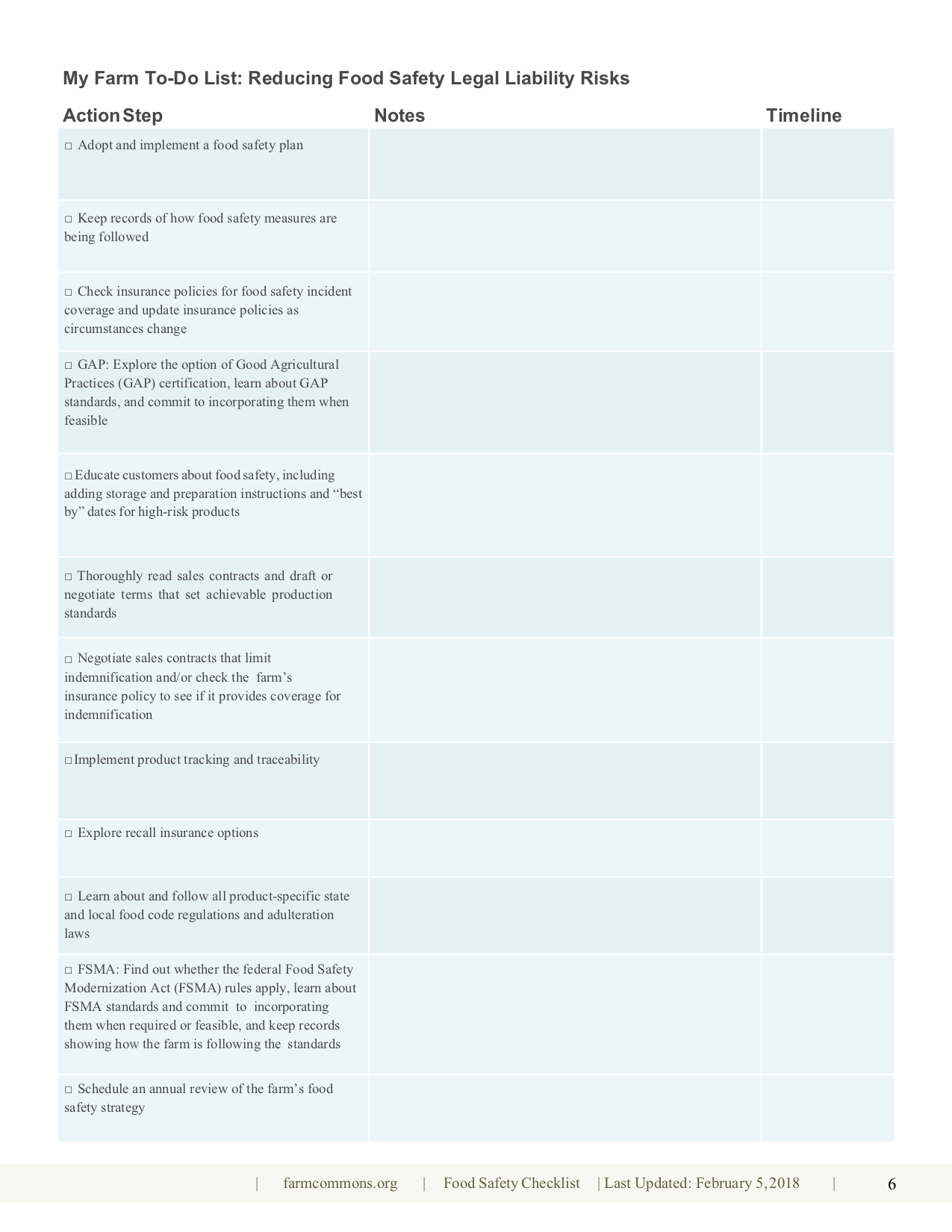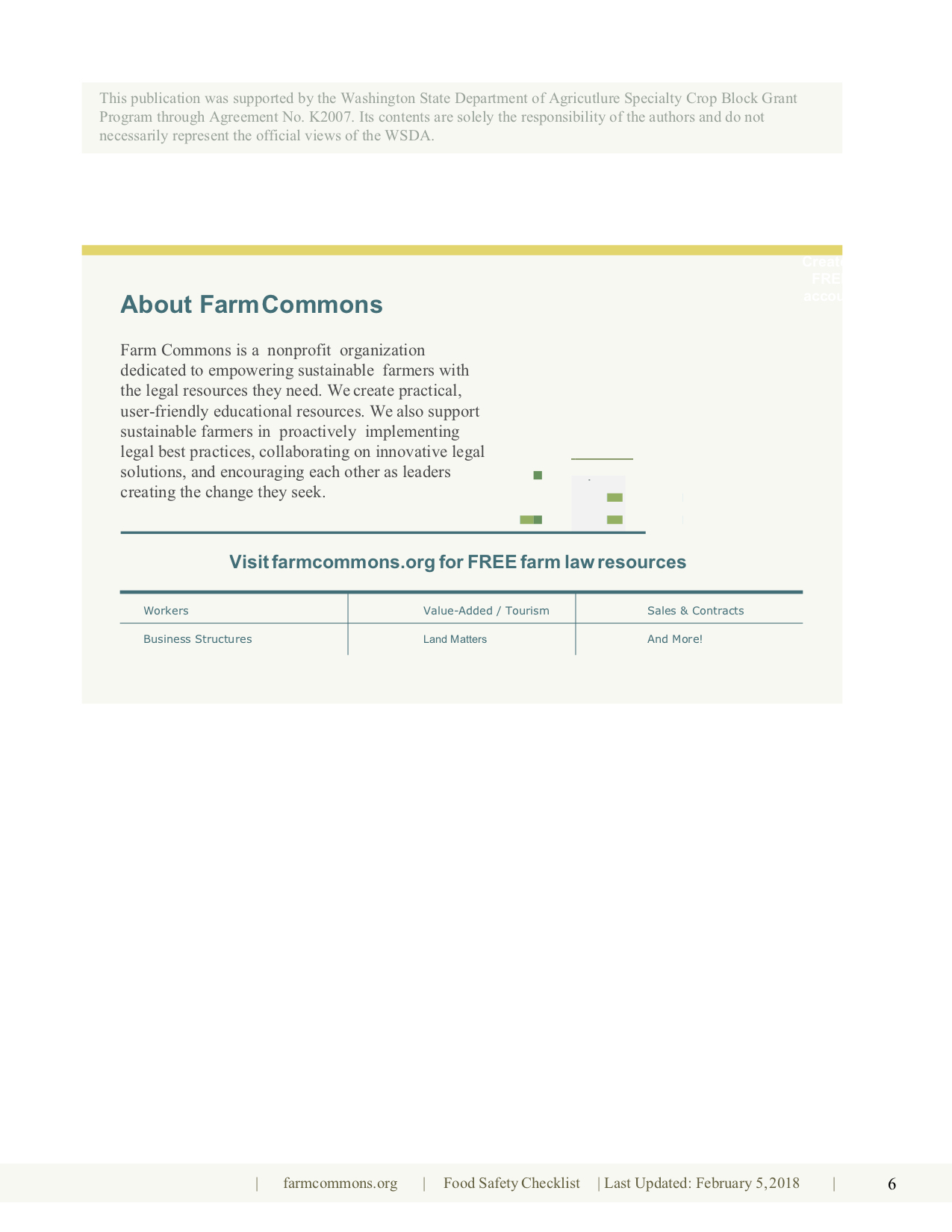12 min read
This checklist shares twelve key steps that farmers can take to reduce their food safety liability.
Did you know Institutional members and Legal Professional members can download this resource as a PDF?
Thinking about food safety isn’t very much fun. The details seem overwhelming and the worst-case scenarios are scary. After all, no farmer wants to get anyone sick. Bottom line, every farmer should prioritize producing the safest food, first and foremost.
Still, attention must be paid to the legal aspects of a food safety incident. Accidents can happen to anyone. How can these risks be mitigated? The good news is that farmers can take tangible, cost-effective steps to minimize their legal liability risks. The following checklist outlines twelve key action steps that farmers can take now.
In the end, the right risk management strategy regarding food safety is a personal decision that depends on you and your farm. Your own financial, emotional, and business considerations all factor into the appropriate strategy for you. Some or all of the action steps identified here can be integrated into an overall food safety strategy that is most suited to your farm.
First and foremost, farms implementing effective food safety plans are less likely to have an incident. If customers happen to get sick, a farm that can show that a food safety plan was being implemented will be in a much better position to defend itself against any impending lawsuits or government enforcement actions.
See pages 3–6 and 13–20 of the Guide
The importance of documentation cannot be emphasized enough! Food safety standards, practices, and protocols that are being followed without records to prove it won’t get a farmer very far if an incident occurs. Maintaining records and documentation can be tedious, but it’s absolutely essential when it comes to limiting your legal liability risks.
See pages 13–20 of the Guide
Having liability insurance is critical in protecting a farm should it become entangled in a foodborne illness lawsuit. If an incident occurs, the decision to sue is not up to the customers. It’s up to third-party insurance companies who are financially motivated to place the burden of damages elsewhere, regardless of whether the farmer is at fault. If you have insurance coverage, your insurance company will defend your case and pay out any damages up to your policy limit. See pages 20–24 of the Guide
Farmers who are GAP certified, or at least have evidence of following certain GAP standards where feasible, will have a stronger defense if they were to get wrangled into a complex foodborne illness lawsuit. That’s because as more farmers become GAP certified, or at least follow GAP standards, the standard of care that a farmer will be held to might increase. In other words, courts might require GAP standards when determining whether the farmer is at fault. See pages 13–15 of the Guide
Farmers can help mitigate their damages in a foodborne illness lawsuit, and, better yet, prevent anyone from getting sick in the first place, if they help educate their customers on how to properly store and prepare the foods they sell. This can be as simple as putting basic instruction notes in CSA boxes, posting signs near bulk bins or the scale and till at farm stands and farmers markets, posting food safety information on their website, and attaching handling and storage instruction fact sheets to delivery invoices for wholesalers. See pages 16–19 of the Guide
Contract breach—or violating the contract terms—is another way farmers may end up with legal consequences from a food safety incident. Many sales agreements obligate farmers to adhere to specific food safety practices or standards—such as GAP certification, quality standards, and so on. When bad things happen everyone along the supply chain starts looking around for ways to eliminate or reduce their damages. A grocery store buyer—or, more likely, their insurance company—might turn to the sales contract to find terms that the farmer wasn’t following. Thoroughly read all sales contracts to be sure you understand your obligations. Agree only to terms you can follow through with; otherwise, try to negotiate different, achievable terms. See pages 28–30 of the Guide
Indemnification is a legal concept or contract term that basically means if Person A does something that harms Person B, Person A will pay Person B back for their damages. In other words, if a farmer allegedly sells a contaminated product to a grocery store that results in lost sales, tainted reputation, or even lawsuits, the farmer would be on the hook for these damages. Indemnification can pile up fast and quickly put a farmer out of business. Fortunately, many insurance policies will cover liability incurred by indemnification. Be sure to either limit the indemnification terms in your sales contracts or seek insurance coverage for the precise types of indemnification you agree to. See pages 26–28 of the Guide
When a food safety incident occurs, one of the primary ways to control the outbreak and mitigate damages is to recall all the potentially affected products. Naturally, this requires some form of a tracking and traceability system. The tracking should be precise enough to order as narrow a recall as necessary. See pages 31–32 of the Guide
Insurance is sometimes available to protect against the expense of a recall. Finding such a policy may take some time. The reality is that recall coverage may only be available as part of a commercial liability policy. It’s worth asking your insurance agent what options are available to you. See page 33 of the Guide
State and local food code regulations include many product-specific requirements, particularly when it comes to processed and value-added products. In addition, all states have food safety laws that generally prohibit the selling of “adulterated” foods. If these rules are not followed, it opens the door to government enforcement action. This risk is always present, but when a food safety incident occurs, the motivation to investigate increases. Farms violating the food safety code or adulteration laws may be fined and have their license revoked. In some states, repeated and willful violations of the rules can even result in a criminal prosecution. Food safety regulations are not something to mess around with. See pages 34-36 of the Guide
The FSMA Produce Safety Rule and Preventive Controls Rule give the Federal Drug Administration (FDA) broad new powers to prevent food safety problems and respond to food safety issues on farms. A number of full and partial exemptions to these rules exist for small farm operations, which are worth looking into. Farms that are required to comply with either or both of these FSMA rules could face fines and even criminal prosecution for violating the standards. While that’s a compelling reason to comply with these rules, it’s not the only reason. Regardless of whether the FSMA rules apply, a farmer can still face a personal injury lawsuit or an enforcement action under state or federal adulteration laws if a foodborne illness is linked to the farm. Farmers who are complying with FSMA standards, and have records to prove it, will have a stronger defense. That’s because courts might turn to FSMA standards when determining whether the farmer is at fault. See pages 37–42 of the Guide
Whatever is decided as a first step, farmers are well-advised to carve out some time each year to revisit, improve, and adapt their overall food safety strategy, including their food safety plan. What’s working and what’s not? Are systems and procedures being followed? Are adequate records being kept? How might documentation, recordkeeping, traceability, or other systems be improved? Have regulations changed or do new regulations apply? A call to your insurance agent should be part of this annual review. Are new or better policies available? See page 44 of the Guide



Join Farm Commons on Thursday, April 24, 2025, at 11 AM CT for a free webinar, where we will share new and improved resources available, and discuss the termination and reapplication activity surrounding the Partnerships for Climate Smart Commodities program, including the opportunity for appeal.